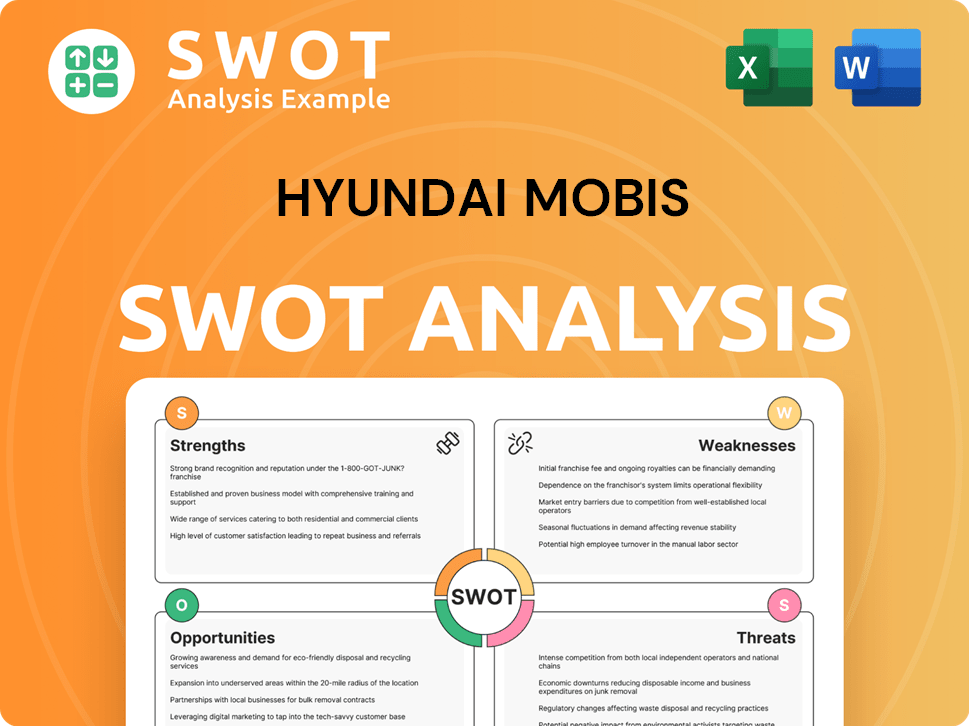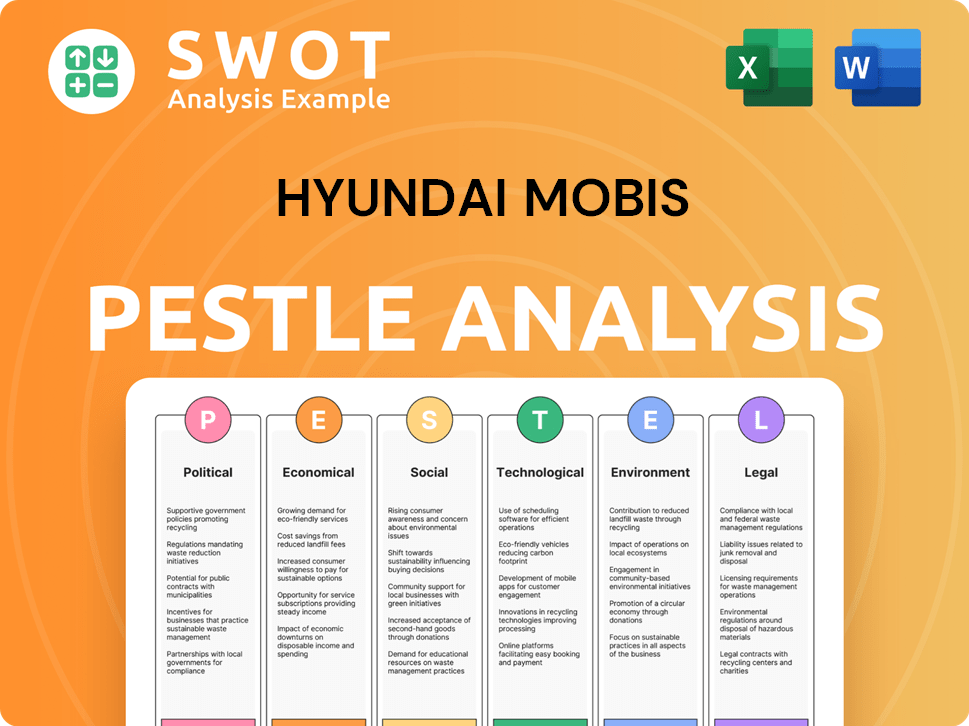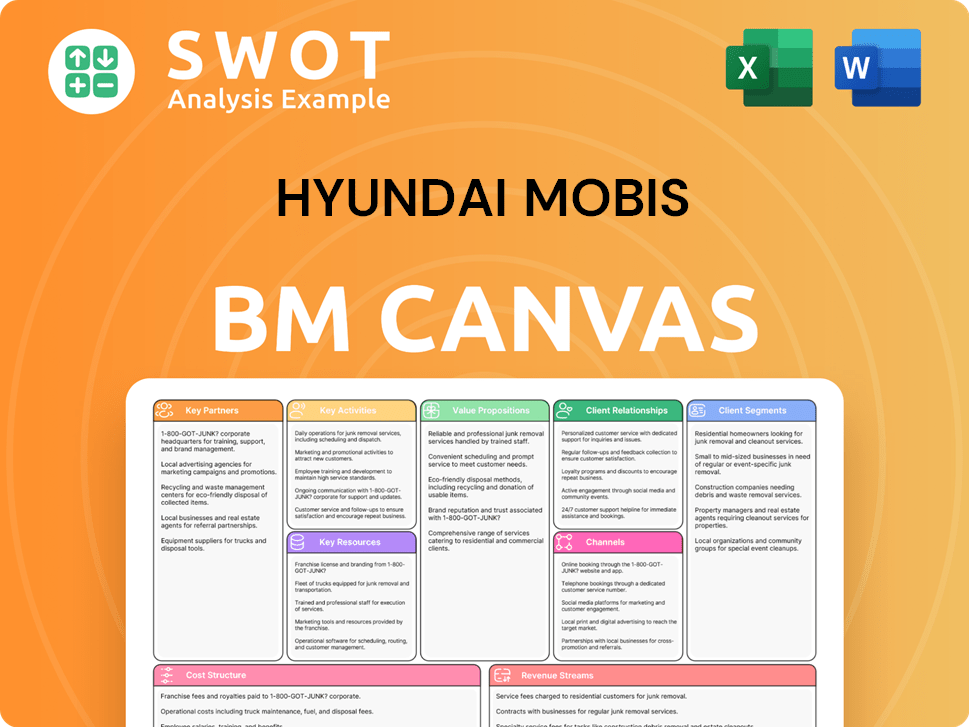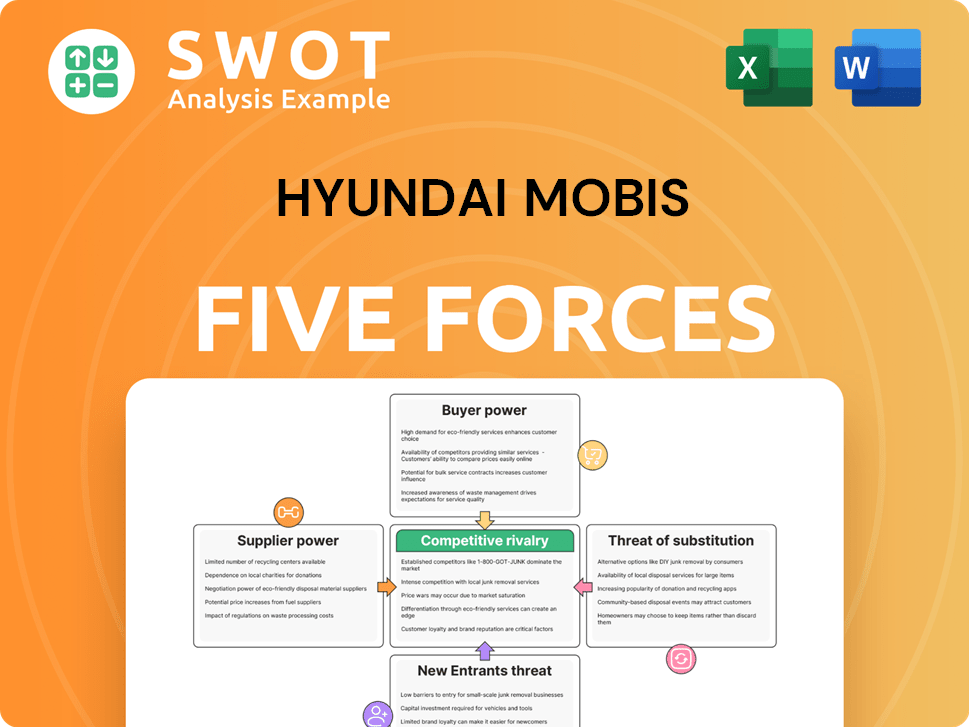Hyundai Mobis Bundle
How Does Hyundai Mobis Navigate the Cutthroat Automotive Market?
The automotive industry is currently experiencing a seismic shift, fueled by autonomous driving and electric vehicle (EV) technologies. Hyundai Mobis SWOT Analysis reveals the company's position in this dynamic environment. Founded in 1977, Hyundai Mobis has evolved from a domestic supplier to a global leader in auto parts manufacturing.

This article will provide a deep dive into the competitive landscape of the Mobis company, examining its market position and strategic moves. We'll uncover its primary rivals and analyze the key differentiators that sustain its success. Gain valuable insights into the industry trends shaping Hyundai Mobis' future, including its competitive advantages and potential challenges.
Where Does Hyundai Mobis’ Stand in the Current Market?
Hyundai Mobis is a major player in the global automotive components industry, consistently ranking among the top suppliers. The company's core operations involve the design, manufacturing, and supply of a wide range of automotive parts and modules. This includes chassis modules, cockpit modules, front-end modules, and advanced driver-assistance systems (ADAS), alongside electrification components.
The value proposition of Hyundai Mobis lies in its ability to provide high-quality, technologically advanced components and modules to automotive manufacturers worldwide. It offers a comprehensive product portfolio, including core components, modules, and after-sales service parts. This ensures that its customers have access to the components they need to produce their vehicles. Hyundai Mobis also focuses on innovation, particularly in areas like autonomous driving, connectivity, and electrification, to stay ahead of industry trends.
In 2023, Hyundai Mobis reported total sales of KRW 59.0 trillion (approximately USD 44.8 billion), demonstrating its significant scale and market presence. The company's strategic shift towards future mobility technologies, such as autonomous driving and electrification, is a key element of its competitive strategy. This proactive approach helps to solidify its position in the evolving automotive market.
Hyundai Mobis holds a strong position in the global automotive components market. While specific market share figures fluctuate, it consistently ranks among the top suppliers. The company is a dominant force in automotive modules, core components, and after-sales service parts.
Hyundai Mobis has a significant global presence with manufacturing and R&D facilities across Asia, Europe, and North America. This diverse geographic footprint allows it to serve a wide range of customers beyond the Hyundai Motor Group. The company's international reach is a key factor in its success.
The company is strategically focused on future mobility technologies, including autonomous driving, connectivity, and electrification. This forward-thinking approach ensures that Hyundai Mobis remains at the forefront of automotive innovation. This strategic pivot is vital for long-term success.
Hyundai Mobis maintains robust financial health, supported by steady investments in R&D and strategic partnerships. This financial strength allows the company to compete effectively with global peers. The company's financial stability is a key competitive advantage.
Hyundai Mobis's strengths include its strong market position, global presence, and technological advancements. The company's ability to innovate and adapt to changing market demands is crucial. Its financial stability supports its growth and competitiveness.
- Strong market position in the automotive industry.
- Global manufacturing and R&D network.
- Focus on future mobility technologies.
- Robust financial performance and investments in R&D.
For more insights into the company's background, you can read the Brief History of Hyundai Mobis. The company's commitment to innovation and its strategic focus on future technologies position it well within the competitive landscape. Hyundai Mobis continues to expand its reach and secure contracts with other global OEMs, solidifying its international footprint. The company's focus on electrification components, such as battery systems and power electronics, is particularly important in the current market.
Hyundai Mobis SWOT Analysis
- Complete SWOT Breakdown
- Fully Customizable
- Editable in Excel & Word
- Professional Formatting
- Investor-Ready Format

Who Are the Main Competitors Challenging Hyundai Mobis?
The competitive landscape for the automotive parts supplier, Hyundai Mobis, is intense, shaped by a global market with numerous established players. The company faces challenges from both direct and indirect competitors, requiring continuous innovation and strategic adaptation to maintain its market position. Understanding the competitive dynamics is crucial for assessing the company's performance and future prospects within the automotive industry.
The automotive industry is undergoing rapid technological advancements, particularly in areas like electric vehicles (EVs), autonomous driving, and connectivity. This evolution intensifies competition as companies vie for market share in these emerging sectors. Hyundai Mobis must navigate these changes while also addressing traditional automotive component markets, making its competitive strategy multifaceted.
The competitive environment for Hyundai Mobis includes major global automotive suppliers. These companies compete across various segments, from powertrain technology and chassis systems to automotive electronics and advanced driver-assistance systems (ADAS). The competitive dynamics are influenced by factors such as technological innovation, pricing strategies, and global distribution networks.
Key direct competitors include major global automotive suppliers such as Bosch, Continental, ZF Friedrichshafen, Denso, and Magna International. These companies compete with Hyundai Mobis across various segments, including ADAS and electrification solutions. They challenge Hyundai Mobis through innovation, pricing strategies, and established global networks.
Bosch, with its extensive portfolio, competes directly with Hyundai Mobis in powertrain technology, chassis systems, and automotive electronics. The company is a significant player in ADAS and electrification solutions. Bosch's strong R&D investments and strategic alliances contribute to its competitive edge.
Continental is a formidable rival, particularly in braking systems, interior electronics, and advanced connectivity solutions. The company's focus on innovation and technological advancements places it as a strong competitor in the automotive industry. Continental's global presence and diverse product offerings contribute to its competitive strength.
ZF Friedrichshafen competes in driveline and chassis technology, as well as active and passive safety systems. The company's focus on these areas makes it a key competitor in the automotive component market. Mergers and acquisitions, like ZF's acquisition of Wabco, further reshape the competitive landscape.
Denso, a Japanese giant, competes across a broad spectrum, including thermal systems, powertrain, and information and safety systems. The company is rapidly expanding its battery and power electronics offerings. Denso's global presence and technological advancements pose a significant challenge to Hyundai Mobis.
Magna International, known for its vehicle manufacturing capabilities and component offerings, competes in module assembly and body & chassis systems. Magna's comprehensive approach and diverse product range make it a strong competitor. The company's global presence and manufacturing capabilities contribute to its competitive advantage.
Indirect competition comes from emerging players focusing on niche technologies, such as lidar or specialized AI for autonomous vehicles. These companies potentially disrupt traditional supply chains. The automotive industry's rapid technological advancements and the shift towards EVs and autonomous driving are reshaping the competitive landscape. For more insights into the company, explore Owners & Shareholders of Hyundai Mobis.
- The race to develop Level 4 and Level 5 autonomous driving technologies has led to intense competition, with companies investing heavily in R&D.
- In the electrification space, companies are rapidly expanding their battery and power electronics offerings.
- Mergers and acquisitions further reshape the competitive landscape by creating larger, more diversified entities.
- Hyundai Mobis must continuously innovate and adapt to maintain its market position.
Hyundai Mobis PESTLE Analysis
- Covers All 6 PESTLE Categories
- No Research Needed – Save Hours of Work
- Built by Experts, Trusted by Consultants
- Instant Download, Ready to Use
- 100% Editable, Fully Customizable

What Gives Hyundai Mobis a Competitive Edge Over Its Rivals?
The competitive landscape of the Hyundai Mobis company is shaped by its strategic alignment with the Hyundai Motor Group (HMG), technological innovation, and global operational capabilities. This provides a strong foundation for its market position in the automotive industry. Understanding these elements is crucial for assessing its competitive advantages and future prospects. For a deeper dive into its financial structure, consider exploring the Revenue Streams & Business Model of Hyundai Mobis.
Hyundai Mobis has consistently invested in research and development, particularly in areas like autonomous driving and electrification. This commitment to innovation is evident in its substantial R&D expenditure, which reached approximately USD 2.3 billion in 2023. Its global presence and robust supply chain also contribute to its competitive edge, ensuring efficient production and timely delivery of components worldwide. The company’s focus on after-sales service further strengthens its market position and customer loyalty.
The company's strategic moves and competitive edge are also influenced by its ability to adapt to rapid technological shifts and the evolving demands of the automotive industry. By leveraging its affiliation with HMG, Hyundai Mobis gains access to a stable demand base and opportunities for early integration into vehicle development processes. This allows for optimized component design and performance, enhancing its competitive advantage in the market.
Hyundai Mobis benefits from its close relationship with Hyundai Motor Company and Kia Corporation. This provides a stable demand base and facilitates economies of scale in production and R&D. Early integration into vehicle development processes leads to optimized component design and performance.
The company invests heavily in R&D, particularly in future mobility technologies. This includes autonomous driving, electrification, and connectivity. R&D expenditure reached approximately USD 2.3 billion in 2023, resulting in a robust patent portfolio and specialized expertise.
Hyundai Mobis has a global manufacturing footprint and a robust supply chain network. This ensures efficient production and timely delivery of components worldwide. It enhances the company's competitive edge by supporting its global operations.
A comprehensive after-sales service network contributes to customer loyalty. It strengthens Hyundai Mobis's market position. This service network is a key factor in maintaining customer relationships and market share.
Hyundai Mobis's competitive advantages include its strong ties to HMG, extensive R&D investments, and global operational capabilities. These factors enable the company to maintain a leading position in the automotive components market. The company's focus on innovation and customer service further enhances its competitive position.
- Strong affiliation with Hyundai Motor Group, ensuring a stable demand base.
- Significant investments in R&D, particularly in future mobility technologies.
- Global manufacturing footprint and robust supply chain for efficient operations.
- Comprehensive after-sales service network, enhancing customer loyalty.
Hyundai Mobis Business Model Canvas
- Complete 9-Block Business Model Canvas
- Effortlessly Communicate Your Business Strategy
- Investor-Ready BMC Format
- 100% Editable and Customizable
- Clear and Structured Layout

What Industry Trends Are Reshaping Hyundai Mobis’s Competitive Landscape?
The automotive components industry, where the Mobis company operates, is experiencing significant shifts. These changes are driven by the rise of electric vehicles (EVs), advancements in autonomous driving, and the increasing demand for connected car features. These trends necessitate substantial investments in research and development and a reevaluation of traditional business models, influencing the Hyundai Mobis competitive landscape.
The industry faces challenges such as the transition to EVs, which requires substantial capital expenditure, and intense competition in autonomous driving. Furthermore, regulatory changes and the entry of tech companies into the automotive sector pose additional threats. Despite these challenges, Hyundai Mobis is positioned to capitalize on opportunities within the evolving automotive industry.
The automotive industry is undergoing a transformation, with a strong focus on electric vehicles (EVs). The global EV market is projected to grow substantially, with EV sales reaching 13.7 million units in 2023, representing a 35% increase from 2022. Autonomous driving technology is also advancing rapidly, requiring significant investment in R&D and strategic partnerships. These trends are reshaping the Hyundai competitive landscape.
Regulatory changes, particularly those related to emissions and safety, are influencing product development and market access. The entry of new players from the tech sector into the automotive space, such as software companies and AI specialists, poses a threat. Geopolitical tensions and supply chain vulnerabilities, as experienced during the semiconductor shortages, also remain persistent challenges for Mobis company.
Hyundai Mobis can capitalize on the burgeoning demand for electrification components, leveraging its expertise in battery systems and power electronics. Strategic partnerships and collaborations are essential to accelerate autonomous driving capabilities and expand software-defined vehicle solutions. The company's strategy includes diversifying its customer base and expanding its global footprint.
Ongoing investments in R&D, particularly in areas like integrated cockpit systems and advanced mobility platforms, position Hyundai Mobis to capture new market share. The company is focused on strengthening its competitive position by proactively addressing challenges and seizing opportunities. To understand more about their strategy, read about the Growth Strategy of Hyundai Mobis.
Hyundai Mobis faces a dynamic industry with both challenges and opportunities. The shift towards EVs and autonomous driving requires strategic adaptation.
- Focus on electrification components and strategic partnerships.
- Invest in R&D for advanced mobility solutions.
- Diversify customer base and expand globally.
- Proactively manage regulatory and competitive pressures.
Hyundai Mobis Porter's Five Forces Analysis
- Covers All 5 Competitive Forces in Detail
- Structured for Consultants, Students, and Founders
- 100% Editable in Microsoft Word & Excel
- Instant Digital Download – Use Immediately
- Compatible with Mac & PC – Fully Unlocked

Related Blogs
- What are Mission Vision & Core Values of Hyundai Mobis Company?
- What is Growth Strategy and Future Prospects of Hyundai Mobis Company?
- How Does Hyundai Mobis Company Work?
- What is Sales and Marketing Strategy of Hyundai Mobis Company?
- What is Brief History of Hyundai Mobis Company?
- Who Owns Hyundai Mobis Company?
- What is Customer Demographics and Target Market of Hyundai Mobis Company?
Disclaimer
All information, articles, and product details provided on this website are for general informational and educational purposes only. We do not claim any ownership over, nor do we intend to infringe upon, any trademarks, copyrights, logos, brand names, or other intellectual property mentioned or depicted on this site. Such intellectual property remains the property of its respective owners, and any references here are made solely for identification or informational purposes, without implying any affiliation, endorsement, or partnership.
We make no representations or warranties, express or implied, regarding the accuracy, completeness, or suitability of any content or products presented. Nothing on this website should be construed as legal, tax, investment, financial, medical, or other professional advice. In addition, no part of this site—including articles or product references—constitutes a solicitation, recommendation, endorsement, advertisement, or offer to buy or sell any securities, franchises, or other financial instruments, particularly in jurisdictions where such activity would be unlawful.
All content is of a general nature and may not address the specific circumstances of any individual or entity. It is not a substitute for professional advice or services. Any actions you take based on the information provided here are strictly at your own risk. You accept full responsibility for any decisions or outcomes arising from your use of this website and agree to release us from any liability in connection with your use of, or reliance upon, the content or products found herein.